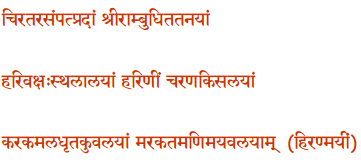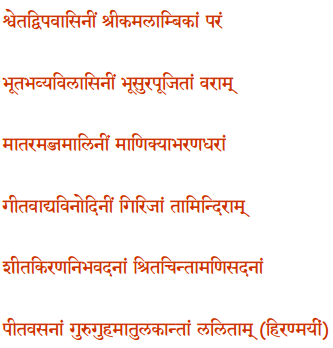"hiraNmayIm lakshmIm sadA bhajAmi" - is classic medieval Raga, dedicated to Shreemati MahaLakshmi-Devi. Composed by Muthuswami Dikshitar.
This article consists of 2 parts and both are of not my pen-writing.
The first part is simpler one, it explains the Kriti and
have been borrowed by me from http://nadhasudharasa.blogspot.ru/2007/10/hiranmayim-lakshmim-lalitha.html
have been borrowed by me from http://nadhasudharasa.blogspot.ru/2007/10/hiranmayim-lakshmim-lalitha.html
The second part is more complex, but I liked it very much as it explains the correlation of "hiraNmayIm lakshmIm sadA bhajAmi" and Shree Lalita Raga. The second part have been borrowed by me from "AV049 - Dikshitar Mahalakshmi Kritis" - http://www.sadagopan.org/index.php/categories/doc_details/387-av049-dikshitar-mahalakshmi-kritis
You can also visit youtube in order to enjoy the word-to-word version of "hiraNmayIm lakshmIm sadA bhajAmi" - http://www.youtube.com/watch?v=TozQ8UcJPiw or see the video in my flickr - https://www.flickr.com/photos/98170374@N03/16705338558/
Pallavi:
hiraNmayIm lakshmIm sadA bhajAmi
hInamAnavAshrayam tyajAmi
Meaning:
dIkshithar sings "I forever ("sadA") worship ("bhajAmi") the golden ("hiraNmayIm") Goddess, Goddess Lakshmi and renounced("tyajAmi") the association of ("Ashrayam") of mean, materialistic persons("hIna"+"mAnava")."
At first glance, the pallavi looks so simple. However, a slightly deeper look reveals the beautiful message dIkshithar wants to convey in these opening lines. He says that he worships Goddess Lakshmi, the giver of wealth but he stays away from rich people who are materialistic.
It is a suggestion of how the mind of a righteous man should be..to worship and long for the grace of God..to bask in the sunlight of the permanent, true and ever-new bliss which God gives and not be merely satisfied with the earthly things and sensual pleasures of this mAya we are all living.
From a musical point of view, the grandeur characteristic of all dIkshithar krithis is once again very evident in these few lines itself. The scope for sangathis and improvisations are immense.
I love the "D M G R" start at "hiraNmayIm"..it makes you stop whatever you are doing and totally grabs your attention and thoughts. Moving on to the anupallavi,
Anupallavi:
chiratara sampatpradAm kshIrAmbudi tanayAm
harivaksha sthalAlayAm hariNIm charana kisalayAm
karakamaladhruta kuvalayAm marakatha maNivaLayAm
Meaning:
dIkshithar describes the compassionate, merciful Goddess as "She bestows("pradAm") her devotees with uncountable and imperishable("chiratara") wealth and treasure("sampath")".
Now dIkshitar starts to describe the physical beauty of the Goddess. He sings "She is the daughter("tanaya") of the ocean("ambudi") of milk("kshIra").
She resides("AlayAm") in the heart("vakshasthala") of Lord Hari. She is the pure one("hariNI") and her feet("charanam") are like tender leaves("kisalayAm").
She possesses("dhruta") in her Lotus-like hands("karakamala"), a blue lotus("kuvalayAm"). She is adorned by bangles("vaLayAm") studded with emeralds("marakatha maNi").
dIkshithar starts the anupallavi with the beautiful "G M M D" phrase at "chiratara" and beautifully builds up to the "D S N D" phrase at "kshIrAmbudhi".
Even before you notice it, the tempo smoothly shifts to madhyamakAla dIkshithar beautifully incorporates 4 shadjamams at "harivakshasthala".
The madhyamakAla sAhityam is an absolute treat. I love the "M G R S, R G R S, R G M" ending at "marakatha maNi vaLayAm".
It beautifully fuses into "hiraNmayIm". It is at instances like these that one wants to give up this mundane life and surrender.
Notice how dIkshithar employs two different words for lotus-kamala and kuvalaya in the same word and brings in the alliteration.
Also notice the amazing prAsam in the entire anupallavi with each word ending with "yAm". Yet another display of genius. And he is not done yet..infact, he does so much arAjagam with the charanam that it consumes you and leaves you yearning for more.
Charanam:
shwEta dwIpa vAsinIm shrI kamalAmbikAm parAm
bhUtha bhavya vilAsinIm bhUsura pUjitAm varAm
mAtaramAbja mAlinIm mAnikya Abharana dharAm
gItavAdhya vinOdinIm girijAntAm indirAm..(san-)
shItha kiraNa nibha vadanAm shrita chintAmaNi sadanAm
pIthavasanAm guruguha mAdhula kAnthAm lalithAm
Meaning:
dIkshithar describes the Goddess as "the one who lives("vAsinIm") in the white lotus("shwEta dwIpa"). She is the supreme, eternal spirit("parAm"), Goddess kamalAmbA.
She makes both the past("bhUtha") and future("bhavya") resplendent("vilAsinIm").
She is worshipped("pUjita") by celestials("bhUsura") and blesses the righteous people("varAm"). The divine mother("mAtaram") is ornamented("Abarana dharAm") with garlands of lotus("Abja") and other precious stones("mAnikya").
She is mAlinI, the creator of all garlands.
She rejoices("vinOdinIm") in the music from the vocal chords("san-gIta") and from instruments("vAdhya"). She is Goddess Indira who enjoys the company of girijA(pArvathi), the daughter of the mountain God himavAn.
Her delicate face("vadanAm") resembles("nibha") the soft rays of moonlight("kshIta kiraNa"). She is chintAmaNi(meaning of this word explained(rather attempt to be explained) a few lines below) for the her devotees("shrita-Ashrita jana"). She is adorned with yellow("pItha") silk robe("vasanAm").
She is the consort("kAnthAm") of Lord VishNu, the maternal uncle("mAdhula") of Lord guruguha. And She is the elegant one("lalithAm").
As I mentioned earlier, the charanam totally usurps the listener and leaves the rasika in a state of sublimity and serenity.
dIkshithar describes the Goddess as chintAmaNi. chintAmaNi is a special gem which is supposed to be decorating the floor of vaikunTa. It is also a very powerful stone which is supposed to have the ability to grant anything one desires.
And so, dIkshithar aptly uses the word to describe the Goddess as the wish-yielding gem for all Her devotees. The last line of the charanam is just too amazing. He beautifully brings in both the composer's mudra as well as the rAga mudhra. dIkshithar cleverly uses the fact that Lord vishNu is the uncle of kArthikEya and brings in the mudra effortlessly. But definitely, dIkshithar finishes the charanam with a bang when he describes the Goddess as lalithA and hence fusing the rAga mudhra.
Musically, the "S R S S S" start to the charanam is absolutely sedate and the "N S R S, R G G M" phrase at "shrI kamalAmbikAm parAm" is soul-stirring.
The "S N D M D N" phrase at vinOdinIm is beauty personified and so is the "n s R G M; D M D N S" phrase at "shrita chintAmaNi sadanAm".
As usual, I am just lost and helpless and I am not able to point pout a single aspect of beauty in this krithi. It is a gem studded with beautiful, precious stones in the form of amazing sAhityams and laced together with bhakthi and prAsam.
The one thing evident throughout the krithi is the scholarly working of the mind of a genius. We have all heard of hitting 2 birds with one stone. dIkshithar seems to always extend this theory and he hits atleast 5 or 6 birds with just a small pebble. He once again proves that he is a phenomenon.
Now the gloss from SADAGOPAN.ORG - "AV049 - Dikshitar Mahalakshmi Kritis" - http://www.sadagopan.org/index.php/categories/doc_details/387-av049-dikshitar-mahalakshmi-kritis:
adiyEn referred to an incident in Dikshithar's life that led to the creation of the Danyaasi Krithi, "Mangala Devathayaa Tvyaa Bahumaanithoham" described previously.
The salutation of MahaaLakshmi as Mangala Devatha was done by Adi Sankara in the first slokam of Kanakadhaaraa stotram.
Dikshitar took then his cue from Adi Sankara.
In this Krithi, he expressed his thanks to M a h a a L a k s h m i for Her intercession to cure the infatuation that his second wife had for jewelry and gold.
He had composed the night before a krithi in Ragam Lalitha requesting such an intercession. There he declared his resolve that he will not approach any wealthy person and beg for favors.
MahaaLakshmi responded to that firm Bhakthi/Vairagyam of Dikshithar and appeared in the dream of his wife, who thereafter lost her desire for worldly wealth.
Hence the Lalitha Raga Krithi and the Dhanyaasi Krithi are very closely connected to that incident in Dikshitar's life.
We will focus on the Lalithaa raga krithi now.
Dikshitar chose the ragam Lalithaa for saluting MahaaLakshmi and expressing his resolve about approaching the wealthy ones of dubious conduct.
This is a Panchama Varja Ragam with the five svarams of Suddha Daivatam, Suddha Rishabham, Suddha Madhyamam, Antara Ghaandhaaram and Kakali Nishadham. This is sung in the jaamam before Sunrise typically for getting the full blessings of the svara Devathaas.
Lalitha Raagam and Vasanthaa Ragam are very close to each other. They differ only in the Daivatha Svaram.
Vasantha has Chatusruhti Daivatham and Lalithaa has Suddha Daivatham. The eduppu for this krithi is Suddha Daivatha Svaram for which this Ragam is famous.
In the spirit of Sri Suktha Vakhyams, "HiranyavarNaam Harineem Suvarna Rajathasrajaam", Dikshitar hails her in Pallavi as "HirNmayeem Lakshmeem".
Sri Suktham visualizes Her with golden hue and adorned with jewelry made of Gold and Silver (Sarvaalankhaara Bhooshithai).
Dikshitar visualized Her as being decked in Gold (Svarna Mayam/HiraNmayee), since his intent was to relate to his wife's desire for the acquisition of a large quantity of Golden jewelry.
He says that he always meditates on MahaaLakshmi as HiraNmayee (HiraNmayeem Lakshmeem Sadhaa Bhajaami).
In the next line of the Pallavi, He expresses his resolve (Heena Maanava Aasrayam Thyajaami) that he will not approach wealthy ones, praise those and seek his fortune from those lowly ones. He states that he rejects that route to acquire wealth to please his wife's cravings for gold.
In Anupallavi, He salutes MahaaLakshmi's place of birth, Her Divya mangala Vigraham and Her Divya AabharaNams.
He points out that the riches obtained with Her blessings are not of a perishable nature (Chira Tara Sampath Pradhaam). He recognizes Her place of birth as the milky ocean (Ksheeraambhudhi Tanayaam) and salutes Her as the daughter of the milky ocean.
He praised next her TENDER feet that are soft like a young, green shoot of plant (Harineem Charana Kisalayaam).
Her place of rest is the chest (Vaksha sthalam) of Sriman Naarayana. Her tender feet with the red dye (MaruthaaNi or Red sandal wood paste) rub on the chest region of Her Lord and leave a red hue as visualized by Swami Desikan:
"PoorNam Teja: Spurathi Bhavathi Paadha Laakshaa-- rasaangam".
Dikshitar praised those tender feet, which are like soft petals of Lotus. In the next salutation, Dikshitar visualized Her as holding the Bhoomandalam in one of Her Lotus hands (Kara kamala Dhrutha Kuvalayaam) to represent Her duties to protect the Earth and its chetanaas and Achetanam.
In the last salutation of the Anupallavi (Maragatha Mani Valayaam) and in the Charana Vaakyams, he enjoys and describes the DivyaabharaNams of MahaaLakshmi, while She is seated in Her throne at Her Residence celebrated as Chintaamani Graham (Sritha Chintaamani Sadhanaam).
Next, he explains as to where the Chintamani Graham is and states that it is in Sveta Dwipam (Sveta Dwipa Vaasineem).
He goes on to describe Her decorations and jewelry through the words,
"Abhja Maalineem, Maragatha Mani Valayaam, Maanikya Aabharana Dharaam".
She is wearing a garland made of Lotus flowers (Abhja Maalini).
She is adorned by a waist band (OttiyaaNam) made of Emeralds (Maragatha Mani Valayaam).
She is wearing AabharaNams made up of precious red stones (Maanikya Aabharana Dharaam).
During this time of holding court in Chintamani Graham, Dikshitar says that Her face looked as though it was defeating the cool, full Moon in its beauty (Seetha Kirana Nibha Vadanaam).
Her status as Jagan Maathaa and Her affection for Her devotees -- both the Devaas and Humans-- and their Aaraadhanams are covered by Dikshitar through the Charana Vakhyams "Bhootha Bhavya Vilasineem, Bhusura Pujithaam Varaam Matharam".
The rest of the Charana Vakhyaams are: "Guru Guha Maathula Kaanthaam, Varaam, Girijaam, Taam, Indiraam, Gita Vadhya Vinodhineem, Srikalaambhikaam, Paraam, Lalithaam, HiraNmayeem, Lakshmeem sadhaa bhajaami".
He recognizes Her as the wife of the uncle of Murugan. He describes Her as being inspired by Sama Gaana Music and the music generated by various instruments like VeeNaa, VeNu, Mrudhangam et al.
He bows before Her giving Darsanam to him in the forms of Jagadhambhikai, Lalithaambhikai and with the Kalaas of Sri Devi.
He states that he worships that golden-hued MahaaLakshmi always.
The article is based on:
2) "AV049 - Dikshitar Mahalakshmi Kritis" - http://www.sadagopan.org/index.php/categories/doc_details/387-av049-dikshitar-mahalakshmi-kritis




